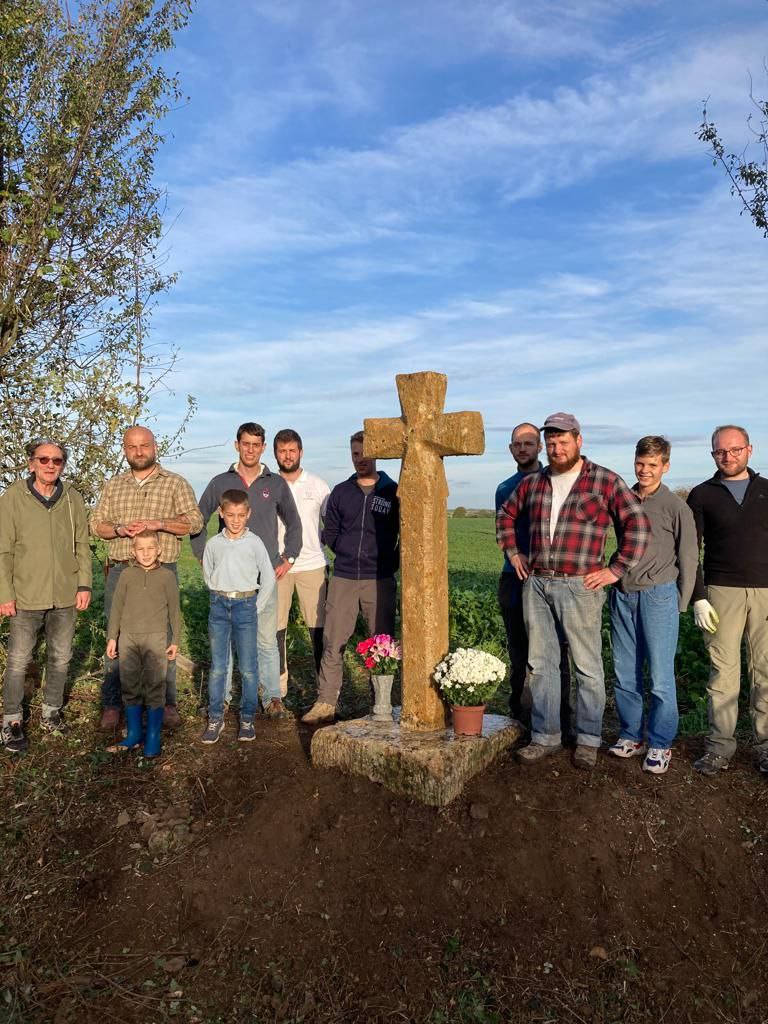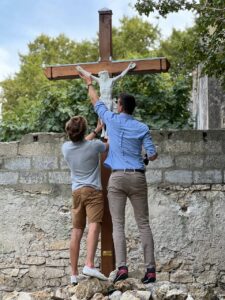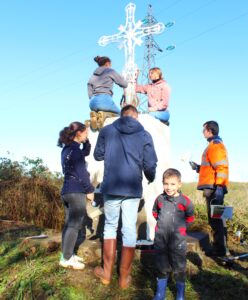S.O.S. Calvaires is a French organisation created to protect the calvary crosses, an important manifestation of religious heritage in France. What started as a small local organisation in the 1980s has recently become a national phenomenon with volunteers and branches in all French regions.
To date, S.O.S. Calvaires has restored over 100 crosses and documented more than 4,000 calvaries in France. Their work has contributed to the appreciation of this major heritage manifestation and revived the interest of local communities. In this interview we learn more about how they have managed to build such a wide network of volunteers and find the necessary resources to operate all over France.

How did the organisation start and why did it focus specifically on calvaries?
In 1987, some elderly people of Le Lion-d’Angers, where our office is located, created a small association in 1987 to protect and restore the Christian heritage consisting of calvaries and little chapels in the area. So this was the germ of the organisation. Then, in 2014 the organisation was taken over by a group of young men, aged between 25 and 30 years old, who changed the name to S.O.S. Calvaires. They put new input in the association and since then we haven’t stopped operating.
 Do calvaries have a special significance in France?
Do calvaries have a special significance in France?
Yes, calvaries have indeed a special significance in French history. They have been erected from the Middle Ages to the middle of the 20th century. In the Middle Ages, they were built to protect travellers on the road. Most of these calvaries were destroyed during the French Revolution with the decline of the Christian mentality and faith. Then during the 19th century, the Catholic Church decided to re-evangelise the French countryside by sending missionary priests to rural areas. These priests erected many crosses in French villages to keep people praying and practising their faith.
Without the calvaries and without these missionaries’ work in the 19th century, most of the people in France would have lost their faith and it would have changed the history of the country. We don’t know how many calvaries there are in France, but all French regions have some. It is quite rare to see a French village without a cross or a statue. The style of the calvaries depends on the region and the period in which they were built. So calvaries are definitely a major heritage manifestation in France.
What are the different stages in the restoration process of the calvaries?
First, we know about the calvaries that need to be restored thanks to people who contact us through social media or through any of our 51 branches. In some cases, it is also the mayor of a village who contacts us directly. After we receive their message, we search for the owner and request authorization. Then we can begin with the restoration.
Restoration of calvaries may involve only cleaning or it may completely change the cross. Everybody can participate in the restoration team. We like to keep this open so that they people living in the area can also be part of the restoration process. After the restoration, we don’t really monitor them, even though we are developing a branch with people from the organization to make sure the crosses will stay in a good condition. But most of the time, the people in the villages take care of the restored calvaries because after participating in a restoration they become part of their lives, their village and their heritage. The restoration work on the calvary makes people rediscover it.
Is it challenging to make a project like this economically sustainable? How did you manage to grow and expand in France?
For now, we don’t receive any governmental support. Only personal donations from people in France and abroad, who know our work and are willing to support it. We constantly look for new donations and funders to continue to grow and to be legitimate in our work and our actions.
We began to be more known in France about two years ago because of the beautiful video we did about a restoration. The video became viral and a lot of people started contacting us to restore calvaries in their regions. Until that moment we only had two full employees working at the organisation, a carpenter to make the new wooden crosses and a secretary. The rest of the staff and the managers of the organisation were volunteers. So thanks to that promotional video, last September S.O.S Calvaires employed two more people, a CEO to manage the direction of the organisation and a communications manager.

In FRH we are aware of the importance of working with local communities as there is always a relationship between them and their heritage. Is this also something you have in mind when planning a restoration? How do you involve and work with local communities?
Of course, we always work together with the local communities. When we work on a calvary, the inhabitants of the village always know what we are doing. We never work in secret. When we need advice, or certain know-how or a specific material, we just ask around. Some people don’t care, but others are very interested in our actions and they are usually impressed to see young people carrying out the restoration and working for the preservation of heritage. We have from children to grandparents. Most of the time, it is a family thing. It is open to everybody, and this way we also contribute to getting people interested in heritage.
We also try to know the history of the calvaries we restore. It happens quite often that the locals know a lot about the calvaries, especially the elder, because in some cases it was their father or their grandfather that built it. They can tell the story of it and this can be quite moving because they don’t usually have the opportunity to speak about it.
You have recently launched an app which users can use to map and upload information about a calvary. Tell us more details about it.
Indeed, we launched an app in November to list all the calvaries, but also statues, small chapels and other heritage manifestations that we have in France and that often go overlooked. It is not only for heritage in disrepair but also for that in good condition. The goal is to make an inventory of all of it in order to keep an account as exact as possible of this part of French Christian heritage. This work has never been done at a national level in French. So it is a very big task for our organisation.
When you open the app, you see the map of France with all the heritage categories available. Now we have around 9,000 sites registered. We can see the exact position of the calvary, some pictures, what material it is made of and its state. As a user, you can also upload a new calvary or site providing all these details.
The app is also very useful for us to know which calvaries need more help and to have a broader vision of this part of French religious heritage. For now, it is only available in France. We will see how it works here and maybe in the future we will consider the possibility of making it available in other countries.

To finish this interview, how can volunteers, professionals and society in general contribute to your mission?
Everybody can come and help restore the calvaries. All you have to do is contact the branch manager of your region and say that you want to help. As easy as that. As I said we have 51 branches in France, but our goal is to have minimum one by department.
Most of the volunteers contact us via social media, while others do it by phone or email. We put them in contact with the manager of their region who informs them in which calvary restoration they can participate.
To be part of the restoration team you don’t need to have special skills. Our volunteers are farmers, architects, lawyers, students, mothers, fathers, builders, businessmen, computer scientists, etc. Sometimes we have parents coming with their kids, sometimes we have 30-year-old people and others 80-year-old people. All you need is good will. Then our regional managers, who receive some training from us to work with a specific calvary, give volunteers the instructions to participate in the restoration.
Video about the restoration of the Calvary of Soulaire-et-Bourg, France.





Follow us: